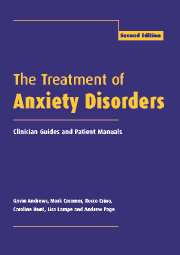Book contents
- Frontmatter
- Contents
- List of authors
- Preface to the second edition
- Abbreviations
- 1 Read me
- 2 General issues in anxiety disorders
- 3 General issues in treatment: Clinician Guide
- 4 Panic disorder and agoraphobia: Syndrome
- 5 Panic disorder and agoraphobia: Treatment
- 6 Panic disorder and agoraphobia: Clinician Guide
- 7 Panic disorder and agoraphobia: Patient Treatment Manual
- 8 Social phobia: Syndrome
- 9 Social phobia: Treatment
- 10 Social phobia: Clinician Guide
- 11 Social phobia: Patient Treatment Manual
- 12 Specific phobias: Syndrome
- 13 Specific phobias: Treatment
- 14 Specific phobias: Clinician Guide
- 15 Specific phobias: Patient Treatment Manual
- 16 Obsessive-compulsive disorder: Syndrome
- 17 Obsessive-compulsive disorder: Treatment
- 18 Obsessive-compulsive disorder: Clinician Guide
- 19 Obsessive-compulsive disorder: Patient Treatment Manual
- 20 Generalized anxiety disorder: Syndrome
- 21 Generalized anxiety disorder: Treatment
- 22 Generalized anxiety disorder: Clinician Guide
- 23 Generalized anxiety disorder: Patient Treatment Manual
- 24 Posttraumatic stress disorder: Syndrome
- 25 Posttraumatic stress disorder: Treatment
- 26 Posttraumatic stress disorder: Clinician Guide
- 27 Posttraumatic stress disorder: Patient Treatment Manual
- 28 Conclusions
- References
- Index
2 - General issues in anxiety disorders
Published online by Cambridge University Press: 05 August 2016
- Frontmatter
- Contents
- List of authors
- Preface to the second edition
- Abbreviations
- 1 Read me
- 2 General issues in anxiety disorders
- 3 General issues in treatment: Clinician Guide
- 4 Panic disorder and agoraphobia: Syndrome
- 5 Panic disorder and agoraphobia: Treatment
- 6 Panic disorder and agoraphobia: Clinician Guide
- 7 Panic disorder and agoraphobia: Patient Treatment Manual
- 8 Social phobia: Syndrome
- 9 Social phobia: Treatment
- 10 Social phobia: Clinician Guide
- 11 Social phobia: Patient Treatment Manual
- 12 Specific phobias: Syndrome
- 13 Specific phobias: Treatment
- 14 Specific phobias: Clinician Guide
- 15 Specific phobias: Patient Treatment Manual
- 16 Obsessive-compulsive disorder: Syndrome
- 17 Obsessive-compulsive disorder: Treatment
- 18 Obsessive-compulsive disorder: Clinician Guide
- 19 Obsessive-compulsive disorder: Patient Treatment Manual
- 20 Generalized anxiety disorder: Syndrome
- 21 Generalized anxiety disorder: Treatment
- 22 Generalized anxiety disorder: Clinician Guide
- 23 Generalized anxiety disorder: Patient Treatment Manual
- 24 Posttraumatic stress disorder: Syndrome
- 25 Posttraumatic stress disorder: Treatment
- 26 Posttraumatic stress disorder: Clinician Guide
- 27 Posttraumatic stress disorder: Patient Treatment Manual
- 28 Conclusions
- References
- Index
Summary
Background information about anxiety disorders
Anxiety disorders are not just a matter of being too anxious. Anxiety is normal. Moderate levels of anxiety are often welcomed to improve performance, and quite severe levels of anxiety can be experienced as normal when they are consistent with the demands of the situation. Persons with anxiety disorders are usually not just complaining of being too anxious too often, for they seek help with specific and recurring fears that they recognize as irrational and somewhat intrusive. To paraphrase the description in Chapter 1: the fears are of physical collapse in panic disorder and agoraphobia, of negative evaluation in social phobia, of harm to self or loved ones in GAD, of self-caused harm to self or loved ones in OCD, of improbable harm to self in the specific phobias, and of the intrusive memory of past threats of harm in PTSD.
It is the specific symptoms and the fear of these symptoms that disables, even though the anxiety that follows is the defining symptom for this group of disorders. It is not surprising therefore that anxiolytic drugs such as the benzodiazepines have not proven to be ideal treatments, for though they reduce both state anxiety and anticipatory anxiety, and hence generally improve composure, they do little to reduce the core fears specific to each disorder. There are general factors that seem to predispose to all anxiety disorders, and treatment should be directed to relieving this general vulnerability, as well as to reducing the fears specific to each disorder. This chapter will present a general model for anxiety that clinicians can teach patients. It is consistent with the cognitive behavioral treatments advocated and allows for the extensive comorbidity that is observed. The chapter will also review diagnosis and assessment, and will consider the epidemiology and health service delivery for these disorders.
A model for anxiety
The Yerkes-Dodson curve
The seriousness of the anxiety disorders is frequently underestimated because anxiety is usually a normal, useful, and protective affect. Depression, on the other hand, is seldom undervalued because it is rarely useful and sometimes dangerous. The notion of the usefulness of anxiety is very important in the management of anxiety disorders.
- Type
- Chapter
- Information
- The Treatment of Anxiety DisordersClinician Guides and Patient Manuals, pp. 5 - 23Publisher: Cambridge University PressPrint publication year: 2002



